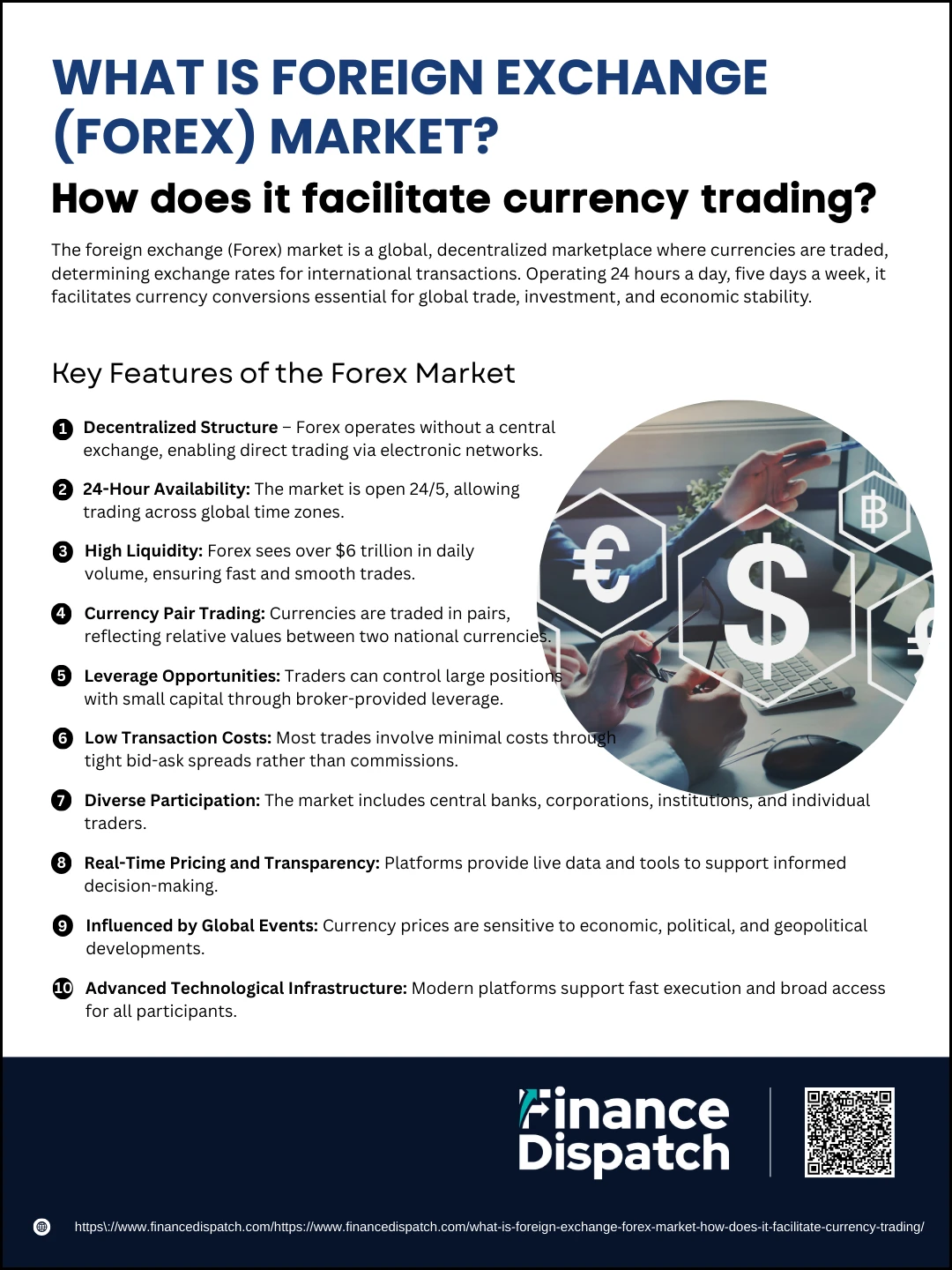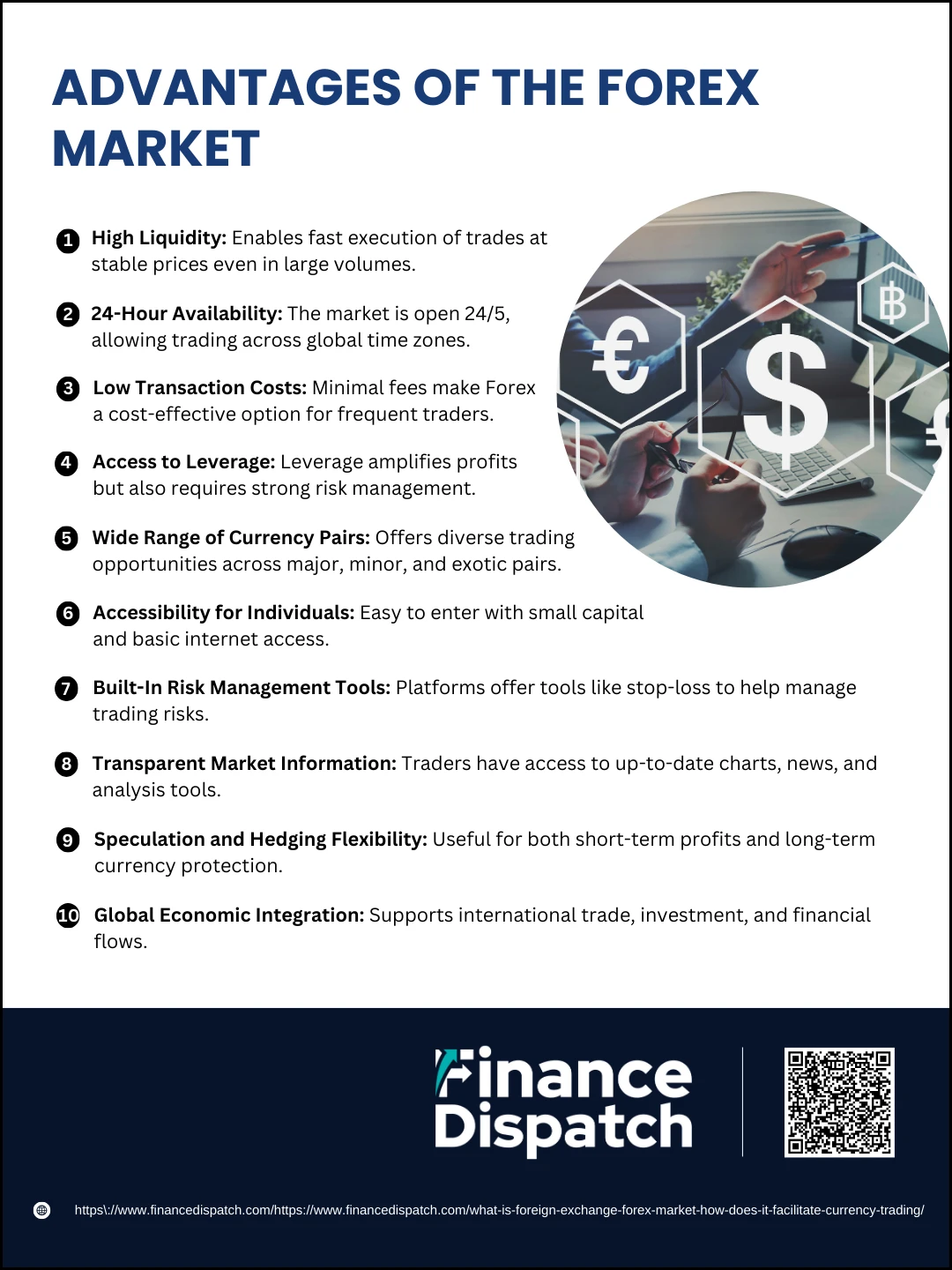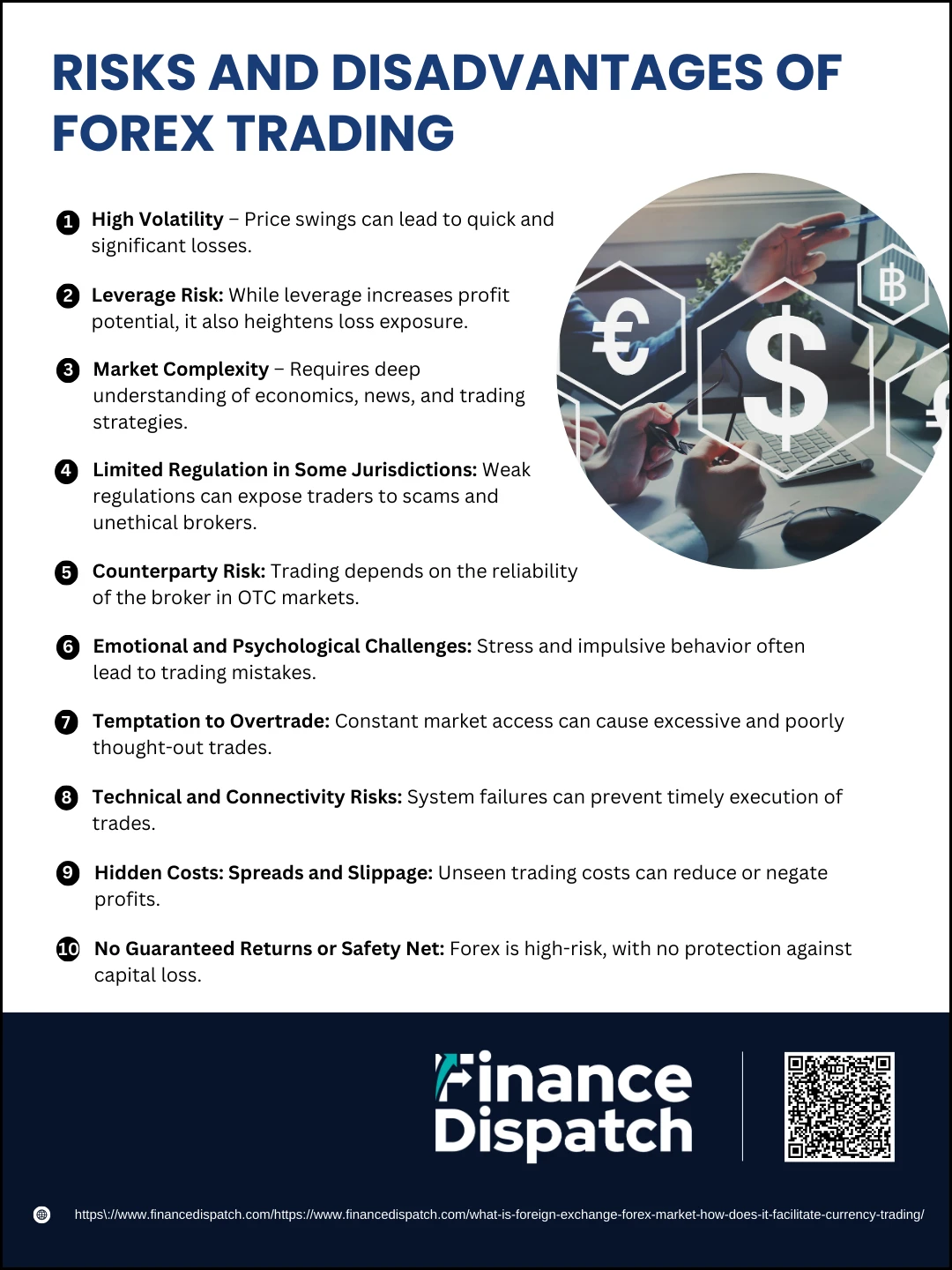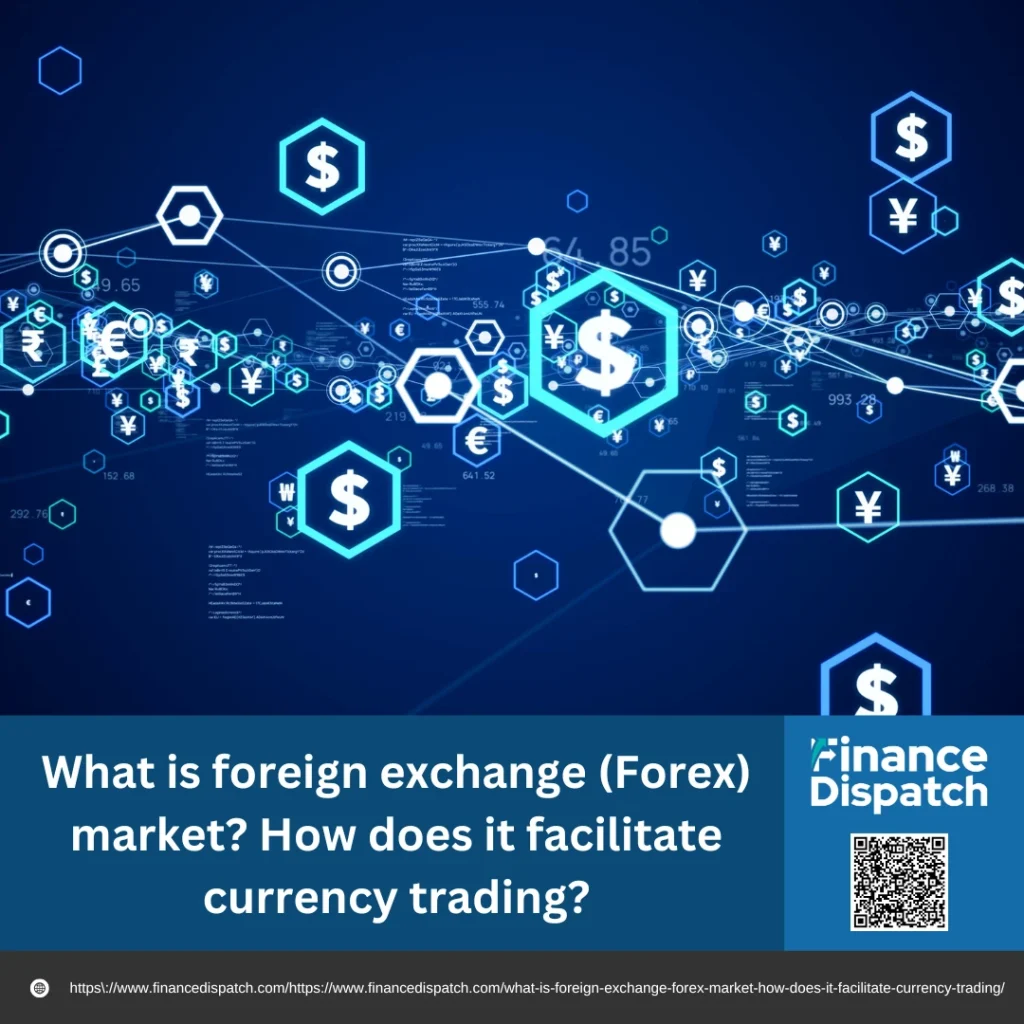The foreign exchange (Forex or FX) market is the world’s largest and most liquid financial marketplace, where global currencies are bought, sold, and exchanged. Operating 24 hours a day across major financial hubs, the Forex market enables seamless currency conversion essential for international trade, investment, and tourism. It plays a crucial role in determining exchange rates through real-time transactions between central banks, commercial institutions, corporations, and individual traders. By providing a platform for currency trading, the Forex market supports cross-border financial activity, hedging strategies, and speculative opportunities, making it a vital component of the global economy.
What is Foreign Exchange Market?
The foreign exchange market, commonly known as the Forex or FX market, is a decentralized global marketplace where currencies are exchanged at current or predetermined rates. It facilitates the conversion of one currency into another, allowing countries, businesses, and individuals to conduct international trade and investment. Unlike traditional financial exchanges, the Forex market operates over-the-counter (OTC) through electronic networks connecting banks, brokers, financial institutions, and traders worldwide. With no centralized location, it runs 24 hours a day, five days a week, enabling continuous trading across different time zones. This dynamic environment makes the Forex market critical for global economic operations.
 Key Features of the Forex Market
Key Features of the Forex Market
The Forex market plays a pivotal role in global finance, enabling the seamless exchange of currencies across borders. Its unique characteristics make it an attractive platform for central banks, financial institutions, corporations, and individual traders. Understanding its foundational features provides valuable insight into why it is the most traded and liquid market in the world. Below are the key features that define the structure and functionality of the Forex market:
1. Decentralized Structure
Unlike stock markets that operate through centralized exchanges, the Forex market is decentralized. Trading occurs directly between parties via electronic networks, without a physical location. This setup ensures continuous operation and global reach.
2. 24-Hour Availability
The Forex market is open 24 hours a day, five days a week. It starts in the Asia-Pacific region (Tokyo and Sydney), moves through Europe (London), and ends in North America (New York). This round-the-clock trading allows participants from different time zones to trade at their convenience.
3. High Liquidity
With over $6 trillion in daily trading volume, the Forex market is the most liquid financial market globally. This liquidity ensures fast order execution and minimal price distortion, even for large trades.
4. Currency Pair Trading
Currencies are traded in pairs (e.g., EUR/USD, USD/JPY), where one currency is bought and the other is sold. The price reflects how much of the quote currency is needed to purchase one unit of the base currency, enabling precise valuation.
5. Leverage Opportunities
Forex brokers offer leverage, allowing traders to control large positions with a relatively small margin. While leverage can amplify profits, it also increases the risk of losses, requiring responsible risk management.
6. Low Transaction Costs
Forex trading generally involves lower costs than other markets. Most brokers earn through the spread (difference between bid and ask price) rather than charging commissions, especially for major currency pairs.
7. Diverse Participation
The market attracts a wide range of participants, including central banks managing reserves, commercial banks facilitating client transactions, multinational corporations hedging currency exposure, hedge funds speculating on trends, and individual retail traders.
8. Real-Time Pricing and Transparency
Forex trading platforms provide real-time access to prices, charts, and market data, allowing traders to make informed decisions based on current information and technical indicators.
9. Influenced by Global Events
Economic releases (like GDP, inflation, interest rates), political developments, natural disasters, and central bank policies significantly influence currency prices, making the market highly reactive and fast-moving.
10. Advanced Technological Infrastructure
Modern Forex trading relies on electronic systems and platforms offering fast execution, algorithmic trading, technical analysis tools, and mobile access. This technology-driven environment supports both institutional and retail participation at scale.
Types of Forex Markets
The Forex market is composed of several sub-markets, each designed to serve specific trading and financial needs. These markets differ based on the type of contract, delivery time, and method of trading. Understanding these types is essential for traders, investors, and institutions to choose the most suitable format for currency transactions, hedging strategies, or speculation.
| Type of Forex Market | Key Features | Purpose |
| Spot Market | Currencies are exchanged immediately at current market rates | Ideal for immediate settlements and real-time trading |
| Forward Market | Customized contracts for future currency exchange at agreed rates | Used by businesses to hedge against currency fluctuations |
| Futures Market | Standardized contracts traded on exchanges for currency delivery at a future date | Offers transparency, regulation, and reduced counterparty risk |
| Options Market | Grants the right, not obligation, to buy or sell currency at a set rate and date | Used for hedging and speculative strategies with controlled risk exposure |
| Swaps Market | Agreements to exchange currency amounts and interest payments over time | Used for managing cash flows and interest rate exposure across currencies |
How Forex Facilitates Currency Trading
The Forex market facilitates currency trading by providing a global platform where buyers and sellers can exchange one currency for another at agreed-upon rates. Since currencies are always traded in pairs—such as USD/EUR or GBP/JPY—the market allows participants to simultaneously buy one currency and sell another. This mechanism supports a wide range of international activities, from trade and investment to tourism and remittances. Forex also enables businesses to hedge against currency risks and helps investors speculate on price movements based on economic trends. Real-time pricing, high liquidity, and the use of electronic trading platforms ensure that currency exchanges are executed quickly and efficiently, making Forex an essential engine of the global economy.
Major Participants in the Forex Market
The Forex market is a vast and dynamic environment involving a wide range of participants, each with different motivations and roles. From large financial institutions to individual traders, these participants contribute to the market’s liquidity and efficiency. Understanding who these players are helps explain the diverse activities that take place in currency trading—whether for profit, risk management, or policy intervention.
1. Central Banks – Manage national monetary policy, stabilize exchange rates, and build foreign currency reserves.
2. Commercial Banks – Facilitate currency exchange for clients and engage in trading to manage liquidity and generate profits.
3. Investment Banks and Financial Institutions – Conduct large-scale trading, investment, and hedging on behalf of clients or for proprietary strategies.
4. Corporations – Engage in Forex to pay for imports, receive export earnings, and hedge against foreign currency risks.
5. Hedge Funds – Speculate on currency movements using leveraged strategies to generate high returns.
6. Retail Traders – Individual traders using online platforms to speculate on currency price changes.
7. Brokerage Firms – Provide trading platforms and market access to retail and institutional clients.
8. Governments and Treasury Departments – Participate in the market to influence exchange rates and implement economic policies.
9. International Organizations – Such as the IMF, which may intervene in Forex markets for financial stabilization and support.
Factors Influencing Exchange Rates
Exchange rates in the Forex market are not fixed; they fluctuate constantly due to various economic, political, and market-related factors. These fluctuations reflect the relative value of one currency against another and are influenced by both short-term events and long-term fundamentals. Understanding the key drivers behind exchange rate movements is essential for traders, investors, and policymakers to make informed decisions and manage risks effectively.
1. Interest Rates – Higher interest rates attract foreign capital, increasing demand for the currency and driving up its value.
2. Inflation Rates – Lower inflation tends to strengthen a currency, while higher inflation erodes purchasing power and weakens it.
3. Economic Indicators – Data such as GDP growth, unemployment rates, and consumer spending influence market expectations and currency values.
4. Political Stability – Stable governments tend to attract more investment, boosting demand for the national currency.
5. Market Sentiment – Investor perceptions and reactions to news, trends, or forecasts can drive sudden currency movements.
6. Trade Balances – A trade surplus supports currency appreciation, while a trade deficit may lead to depreciation.
7. Speculation – Traders’ expectations about future currency movements can influence buying or selling activity in the market.
8. Central Bank Policies – Monetary interventions, such as adjusting interest rates or currency buy/sell operations, directly affect exchange rates.
9. Global Events – Wars, natural disasters, pandemics, and geopolitical tensions can cause sharp fluctuations in currency values.
 Advantages of the Forex Market
Advantages of the Forex Market
The foreign exchange (Forex) market stands out as the most active and liquid financial market in the world, offering a wide range of benefits that appeal to both institutional and retail participants. Its decentralized nature, technological accessibility, and constant operation provide flexibility and efficiency unmatched by other markets. These advantages make Forex trading an appealing choice for those seeking opportunities in international finance, speculation, or risk management. Below are the major advantages that define the Forex market:
1. High Liquidity
The Forex market has a daily trading volume exceeding $6 trillion, making it the most liquid market globally. This ensures that orders can be executed quickly at predictable prices, reducing the risk of slippage and allowing traders to enter and exit positions with ease—even in large volumes.
2. 24-Hour Market
Forex operates continuously from Monday to Friday, across global financial centers such as London, New York, Tokyo, and Sydney. This around-the-clock trading enables participants to react instantly to news and events, and provides flexibility for traders in different time zones.
3. Low Transaction Costs
Unlike stock or commodities trading, Forex typically involves very low fees. Most brokers earn through the bid-ask spread rather than charging commissions, especially on major pairs like EUR/USD, making trading more cost-effective for frequent participants.
4. Access to Leverage
Forex brokers offer leverage—sometimes up to 100:1 or higher—allowing traders to open larger positions with a relatively small amount of capital. While leverage increases potential profits, it also magnifies risk, making disciplined risk management crucial.
5. Wide Range of Currency Pairs
The market offers a broad selection of currency pairs, including major (USD/EUR), minor (GBP/JPY), and exotic pairs (USD/TRY), giving traders multiple options to explore various economies and trading strategies.
6. Accessibility for Individuals
The entry barrier in Forex is low. With just a small deposit and an internet-connected device, anyone can open a trading account and start participating, making it accessible to beginners and retail traders worldwide.
7. Built-In Risk Management Tools
Most trading platforms offer features like stop-loss orders, trailing stops, and limit orders, which help traders control risk, protect profits, and manage volatility more effectively.
8. Transparent Market Information
The Forex market provides real-time access to pricing, economic news, technical indicators, and charts. This transparency helps traders make data-driven decisions and monitor market conditions as they evolve.
9. Speculation and Hedging Flexibility
Participants can engage in short-term speculation for quick gains or use Forex instruments to hedge against currency exposure in international trade, investments, or loans, depending on their financial goals.
10. Global Economic Integration
Forex trading connects markets and participants from every corner of the globe. It plays a critical role in supporting international business, travel, and cross-border investment by ensuring smooth currency conversion and efficient capital flow.
 Risks and Disadvantages of Forex Trading
Risks and Disadvantages of Forex Trading
The Forex market is widely praised for its accessibility, liquidity, and profit potential. However, behind these advantages lie considerable risks that can pose serious challenges, especially to novice or underprepared traders. Unlike traditional investments, Forex trading is highly speculative and fast-moving, often requiring a deep understanding of global economics, disciplined strategies, and emotional control. Without these, the potential for loss can be just as great—if not greater—than the opportunity for gain. Below are the key risks and disadvantages of participating in the Forex market:
1. High Volatility
Forex markets react quickly to political developments, economic news, interest rate changes, and natural disasters. These rapid and unpredictable price fluctuations can result in sharp losses within minutes, especially for traders holding highly leveraged positions.
2. Leverage Risk
One of the most attractive yet dangerous features of Forex trading is leverage. While it allows traders to control large positions with a small margin, it also magnifies losses. A 1% unfavorable move in the market can completely wipe out a heavily leveraged account, making proper risk management essential.
2. Market Complexity
Forex markets are influenced by a wide array of factors—macroeconomic indicators, central bank decisions, global trade flows, and geopolitical shifts. Understanding and analyzing these elements requires time, experience, and ongoing education, which many beginners may lack.
3. Limited Regulation in Some Jurisdictions
Unlike the stock market, the Forex market operates in a decentralized, over-the-counter format with no central exchange. In countries with weak or absent regulatory frameworks, traders risk encountering dishonest brokers, misleading platforms, or outright frauds.
4. Counterparty Risk
In OTC trading, your broker is your direct counterparty. If the broker goes bankrupt or fails to execute your trades as promised, you may not recover your funds. This makes it important to choose regulated, well-capitalized brokers with a solid reputation.
5. Emotional and Psychological Challenges
Forex trading can be emotionally exhausting. The speed of the market and pressure to make quick decisions often lead to anxiety, overconfidence, revenge trading, or panic. Emotional trading frequently results in poor decision-making and significant losses.
6. Temptation to Overtrade
Because the market is open 24 hours a day, five days a week, traders may feel pressured to stay active constantly. This can lead to overtrading—placing too many trades without proper analysis—resulting in poor judgment and compounded losses over time.
7. Technical and Connectivity Risks
Online Forex trading relies heavily on internet access and trading platforms. Server outages, lagging software, or internet disruptions can cause traders to miss key opportunities or fail to close losing positions in time.
8. Hidden Costs: Spreads and Slippage
Although Forex brokers promote low or no commission trading, traders still pay the spread—the difference between the buying and selling price. During volatile markets or news releases, spreads can widen unexpectedly. Additionally, slippage (when a trade executes at a worse price than expected) can affect profitability.
9. No Guaranteed Returns or Safety Net
Forex trading offers no guaranteed returns. Unlike bank savings or some bonds, there is no principal protection. Without a clear strategy, education, and consistent discipline, even experienced traders can suffer heavy losses. This makes Forex inherently high-risk and unsuitable for those who cannot afford to lose their capital.
Economic Impact of Forex Market
The Forex market plays a significant role in shaping global and national economies by facilitating currency conversion, influencing exchange rates, and enabling cross-border trade and investment. Through the continuous pricing of currencies, Forex determines the cost of imports and exports, affecting a country’s trade balance and competitiveness in the global market. A strong domestic currency can make exports more expensive and reduce foreign demand, while a weaker currency can boost exports by making goods cheaper internationally. Additionally, exchange rate movements impact inflation, foreign capital flows, tourism, and monetary policy decisions by central banks. The Forex market also affects investor confidence, as stable and predictable exchange rates attract foreign investment, while volatility may deter it. In essence, the Forex market acts as a barometer of economic health and a mechanism for transmitting financial signals across borders, making it a vital component of global economic stability and growth.
Conclusion
The foreign exchange (Forex) market is a cornerstone of the global financial system, enabling the seamless exchange of currencies that fuels international trade, investment, and economic cooperation. With its 24-hour accessibility, high liquidity, and vast participant base, it offers unique opportunities for both institutions and individual traders. However, these opportunities come with inherent risks, including volatility, leverage exposure, and market complexity. By understanding the structure, key features, participants, and influencing factors of the Forex market, individuals and businesses can make more informed decisions and better manage currency-related risks. Ultimately, the Forex market’s dynamic nature not only facilitates economic interaction between nations but also reflects the broader health and direction of the global economy.



